Cucurbit Genetics Cooperative Report 6:16-17 (article 8) 1983
K. Lertrat and R. L. Lower
University of Wisconsin, Madison, WI 53706
In an inbred-hybrid breeding system, inbred line development or extraction is preceded by a population improvement phase. Full-sib family selection as proposed by corn breeders (1, 2, 4) is a suitable method for extracting inbred lines from two improved populations. This selection procedure involves selfing and crossing between individuals from two populations. Individual crosses are evaluated and the selfed progenies of plants used in the crosses are selected for future population generations. This procedure is followed until the selfed progenies of plants used in the selected crosses are homozygous and homogenous (Fig. 1). An investigation of this procedure in maize suggests that it leads to extraction of inbred lines with improved combining ability with greater efficiency than the more standard inbred-hybrid selection systems (3).
This inbred line development program has been practiced in pickling cucumbers for one year with the goal of increasing fruit yield in a once-over mechanical harvesting system. Two improved pickling cucumber populations, HSE-C3 (hardwickii semi-exotic, cycle 3) and GS-C3 (gynoecious synthetic, cycle 3), resulted from three cycles of S1 selection (5).
Average fruit yield of 106 S0 x S0 (HSE-C3 X GS-C3) crosses was 2.32 fruit per plant, ranging from 1.06 to 4.88 fruit per plant (Table 1). This average fruit yield was not significantly higher than the average of six check hybrids. Also, mean yield was less than that for a well-adapted hybrid, ‘Calypso’. Twenty-two selfed lines from both populations (HSE-S1 and GS-S1) were selected on the basis of hybrid performance (selection intensity = ca. 20%) for continuing the selection program. Fruit yield of selected crosses was 3.27 fruit per plant.
Table 1. Summary of a cycle of selection using full-sib family selection, a comparison of number of fruit per plant at optimum once-over harvest time.
Family |
S0 x S 0 |
S.D. |
Range |
| All crosses (106) | 2.32 | 0.45 | 1.06–4.88 |
| Selected crosses (22) a | 3.27 | 0.54 | 2.78–4.88 |
| Average of checks (6) b | 1.84 | 0.39 | 1.33–2.66 |
| Average of Calypso | 2.50 | 0.45 | 2.33–2.64 |
| LSD.05 | 0.89 |

Figure 1. Outline of full-sib family selection.
Literature Cited
- Hallauer, A. R. 1967a. Development of single-cross hybrids from two-eared maize populations. Crop Sci. 7:192–195.
- Hallauer, A. R. 1967b. Performance of single-cross hybrids from two-eared maize populations. Ann. Hybrid Corn Ind. Res. Conf. Proc. 22:74–81.
- Hoegenmeyer, T. C. and A. R. Hallauer. 1976. Selection among and within full-sib families to develop single crosses of maize. Crop Sci. 16:76–81.
- Lonnquist, J. H. and N. E. Williams. 1967. Development of maize hybrids through selection among full-sib families. Crop Sci. 7:369–370.
- Nienhuis, J. 1982. Response to different selection procedures for increased fruit yield in two pickling cucumber populations, Ph.D. Thesis. University of Wisconsin-Madison.